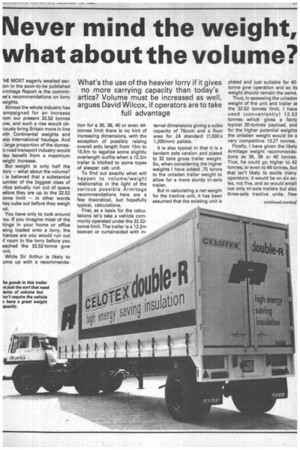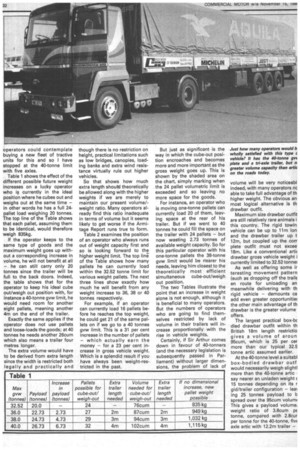Never mind the weight, what about the volume?
Page 33

Page 34

Page 35

If you've noticed an error in this article please click here to report it so we can fix it.
HE MOST eagerly awaited secion in the soon-to-be published 1rmitage Report is the commitee's recommendations on lorry veights.
Almost the whole industry has ampaigned for an increase ram our present 32.52 tonnes tvw, and such a rise would obiously bring Britain more in line with Continental weights and telp international haulage. And large proportion of the domesic road transport industry would ilso benefit from a maximum weight increase.
But weight is only half the tory — what about the volume? : is believed that a substantial lumber of the biggest class of Irtics actually run out of space lefore they are up to the 32.52 onne limit — in other words hey cube out before they weigh tut.
You have only to look around 'au. If you imagine most of the hings in your home or office teing loaded onto a lorry, the hances are you would run out if room in the lorry before you eached the 32.52-tonne gvw mit.
While Sir Arthur is likely to ome up with a recommenda
tion for a 36, 38, 40 or even 44tonnes limit there is no hint of increasing dimensions, with the exception of possibly raising overall artic length from 15m to 15.5m to legalise some slightly overlength outfits when a 12.2m trailer is hitched to some types of sleeper cab unit.
To find out exactly what will happen to volume/weight relationship in the light of the various possible Armitage recommendations here are a few theoretical, but hopefully typical, calculations.
First, as a basis for the calculations let's take a vehicle commonly operated under the 32.52tonne limit. The trailer is a 12.2m boxvan or curtainsided with in
ternal dimensions giving a cubic capacity of 76cum and a floor area for 24 standard (1,000x 1,200mm) pallets.
It is also typical in that it is a tandem axle version and plated to 32 tons gross trailer weight. So, when considering the higher weights I have added .75 tonne to the unladen trailer weight to allow for a more sturdy tri-axle trailer.
But in calculating a net weight for the tractive unit, it has been assumed that the existing unit is
plated and just suitable for 40tonne gvw operation and so its weight should remain the same.
Thus, in assessing the unladen weight of the unit and trailer at the 32.52 tonnes limit, I have used (conveniently) 12.52 tonnes which gives a fairly typical 20-tonnes payload, and for the higher potential weights the unladen weight would be a very competitive 13.27 tonnes.
Finally, I have given the likely Armitage weight recommendations as 36, 38 or 40 tonnes. True, he could go higher to 42 tonnes, or even to 44 tonnes, but that isn't likely to excite many operators; it would be on six axles, not five, and so would entail not only tri-axle trailers but also three-axle tractive units. Few operators could contemplate buying a new fleet of tractive units for this and so I have stopped at the 40-tonne limit with five axles.
Table 1 shows the effect of the different possible future weight increases on a lucky operator who is currently in the ideal position where he cubes out and weighs out at the same time — in other words he has a full 24pallet load weighing 20 tonnes. The top line of the Table shows that each pallet, assuming them to be identical, would therefore weigh 835kg.
If the operator keeps to the same type of goods and the maximum weight goes up without a corresponding increase in volume, he will not benefit at all — he can still carry only 20 tonnes since the trailer will be full to the back doors. Indeed, the table shows that for the operator to keep his ideal cube out/weigh out position with, for instance a 40-tonne gvw limit, he would need room for another eight pallets, meaning another 4m on the end of the trailer.
Exactly the same applies if the operator does not use pallets and loose-loads the goods; at 40 tonnes he needs another 26cum which also means a trailer four metres longer.
The extra volume would have to be derived from extra length since the width is restricted both legally and practically and though there is no restriction on height, practical limitations such as low bridges, canopies, loading banks and extra wind resistance virtually rule out higher vehicles.
So that shows how much extra length shoult1 theoretically be allowed along with the higher weights if we are merely to maintain our present volume!weight ratio. Many operators already find this ratio inadequate in terms of volume but it seems likely to get worse if the Armitage Report runs true to form.
Table 2 examines the position of an operator who always runs out of weight capacity first and so is looking forward to the higher weight limit. The top line of the Table shows how many pallets he can currently load within the 32.52 tonne limit for various weight pallets. The next three lines show exactly how much he will benefit from any weight increase to 36, 38 or 40 tonnes respectively.
For example, if an operator can currently load 16 pallets before he reaches the top weight, he could get 21 of the same pallets on if we go to a 40 tonnes gvw limit. This is a 31 per cent increase in the number of pallets — which actually earn the money — for a 23 per cent increase in gross vehicle weight. Which is a splendid result if you have always been weight-restricted in the past. But just as significant is the way in which the cube-out position encroaches and becomes more and more important as the gross weight goes up. This is shown by the shaded area on the chart, simply marking when the 24 pallet volumetric limit is exceeded and so leaving no more space for the goods.
For instance, an operator who is moving one-tonne pallets can currently load 20 of them, leaving space at the rear of his trailer. But if we went to 40 tonnes he could fill the space on the trailer with 24 pallets — but now wasting 2.73 tonnes of available weight capacity. So for this particular operator with his one-tonne pallets the 38-tonne gvw limit would be hearer his needs, leaving him closest to the theoretically most efficient simultaneous cube-out/weigh out position.
The two Tables illustrate the point that an increase in weight alone is not enough, although it is beneficial to many operators. But the numbers of operators who are going to find themselves restricted by lack of volume in their trailers will increase proportionally with the rise in vehicle weights.
Certainly, if Sir Arthur comes down in favour of 40-tonners (and the necessary legislation is subsequently passed in Parliament) without larger dimensions, the problem of lack of volume will be very noticeabl indeed, with many operators nc able to take full advantage of th higher weight. The obvious an most logical alternative is th drawbar outfit.
Maximum size drawbar outfit are still relatively rare animals i this country. The rigid towin vehicle can be up to 11m Ion and the drawbar trailer up t 12m, but coupled up the corr plete outfit must not excee 18m. Like a conventional arti( drawbar gross vehicle weight i currently limited to 32.52 tonne: As well as offering some ir teresting movement pattern (such as dropping off the trailE en route for unloading an meanwhile delivering with th rigid vehicle — demounts ca add even greater opportunitief. the other main advantage of th drawbar is the greater volume offers.
The largest practical box-bc died drawbar outfit within th British 18m length restrictio gives a volume of aroun 95cum, which is 25 per cer more than our typical 32.5 tonne artic assumed earlier.
At the 40-tonne level a suitabl box-bodied drawbar outf would necessarily weigh slightl more than the 40-tonne artic • say nearer an unladen weight 15 tonnes depending on its r gid/trailer configuration — lea) ing 25 tonnes payload to b spread over the 95cum volum( This gives a payload volume. weight ratio of 3.8cum pc tonne, compared with 2.8cur per tonne for the 40-tonne, fiv( axle artic with 12.2m trailer — 5 per cent volume advantage ar the drawbar.
In other words, the operators ind there will be quite a umber) who are going to be aoking for more volume if and then Sir Arthur gives us more 'eight could get a theoretical 35 er cent gain by switching to an Elm 40 tonne drawbar outfit. Coincidentally, the 3.8cum per inne payload volume/weight
ratio of such a drawbar is near identical to the ratio that is currently offered by the conventional 32.52-tonne artic. So the operator who finds today's volume/weight mix just right should be very satisfied turning to drawbars if we ever get the 40tonne limit. He will get the same volume/weight ratio but 25 per cent extra productivity.
The drawbar manufacturers are, of course, well aware of the potential market that lies ahead if Sir Arthur recommends as expected. Already, one drawbar manufacturer reports a healthy level of inquiries, which must be significant in the present economic climate, where the trailer market is so slow.
But the advantages of the drawbar system could be even greater, say its supporters, if our 18m drawbar length restriction was raised. They would generally seem to favour a 22m limit which would give enormous volume capacity for those who needed it.
Though the 18m limit for drawbars is almost universal throughout Western Europe, two countries, acknowledged to be leaders in drawbar operations, allow larger dimensions.
Sweden allows 24m outfits and Finland goes for 22m. Vehicles of this size are everyday sights on Scandinavian roads; they are not novelties as theii smaller brothers are in thiE country.
The Swedes seem to haw few, if any, problems even with their lengthy and heavy — up tc 52 tonnes gvw — drawbars anc this bears out what the British manufacturers say. Properly sel up with the correct rigid/drawba balance and coupling geometry such outfits are safe, stable, dc not snake at speed, and are easy to manoeuvre, claim the manufacturers.
Research and examination ol accident statistics in other countries also seems to confirm that even the largest drawbars can at least equal the safety oi conventional artics.
Unfortunately, public and environmental hostility towards the drawbar is probably even stronger than it is against heavier lorries. The Greater London Council has already declared its animosity (CM, July 26, 1980).
Maybe this is the next nettle that must be grasped by the road transport industry. All being well, we are just a few (admittedly rather large) steps away from heavier lorries. Their economies of operation are already well-documented.
CM demonstrated this with its series of road tests at 40 tonnes (CM, October 25, 1980) and concluded that they can be operated safely, more economically, and without adding to road damage.
The advantages of the heavier lorry can only be fully utilised if dimensions and hence volume are correspondingly increased. The operators and manufacturers will be unpopular to suggest it, but surely this is one of the next major steps towards greater operating efficiency.




























































































































